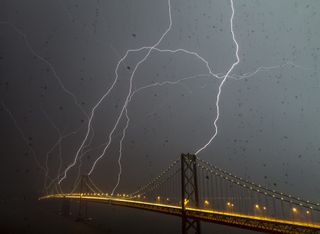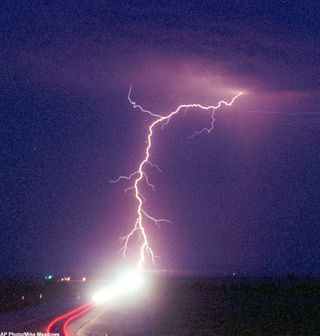When Lightning Strikes: A Photographer's Experience Going Viral

It was a dark and stormy night, and San Francisco resident Phil McGrew had his camera ready.
The currency trader and amateur photographer had long wanted to get a shot of lightning striking the iconic Bay Bridge. He got his chance the night of April 12, only a week after he'd bought a new camera.
Using an iPad app called Lightning Finder, McGrew tracked the storm as it rolled toward his home. He tried to put the camera on the balcony, but blowing rain threatened to ruin it. Instead he brought the camera into his home office and set it to take continuous shots with 20-second exposures.
Out of 136 exposures, three captured lightning bolts striking the bridge.
McGrew uploaded one stunning shot to the photo-sharing site Flickr. It showed bolts hitting all the towers of the bridge during one 20-second period.
A phone call to the local NBC affiliate got the shot on the 11 p.m. local news. McGrew went to bed without expecting much more to come of it, but at 1 a.m. local time a photo distribution company called asking to negotiate for distribution rights. McGrew agreed, and woke up the next morning to find that the photo had run in several European publications overnight. It was soon being shared all over the Internet. [See a Gallery of McGrew's Photos]
A month after McGrew's 15 minutes of media fame, LiveScience caught up with him to talk photography, lucky lightning strikes and sudden popularity.
Sign up for the Live Science daily newsletter now
Get the world’s most fascinating discoveries delivered straight to your inbox.
LiveScience: How did you capture this shot?
McGrew: The evening news said there was a possibility of thunder moving through the area. You know, in the Bay area it's extremely rare to see thunder and lightning. I moved out here from south Florida so it's almost a daily occurrence there, but here it's extremely rare.
After, I scrolled through the camera, and on the first 20 or 30 you could see a little bright spot to the left or the right where the camera had just missed it. I didn't think I had caught anything, but I just kept scrolling there and within a couple pictures of each other I had gotten three frames where the lightning struck.
LiveScience: Your office window has a really great view.
McGrew: Yeah, I can't complain.
LiveScience: So when did you realize the photo had gone viral?
McGrew: The first thing that happened is I uploaded it and looked at it and called my girlfriend in. I think at that point we knew it was a really cool photo. It was something I had wanted to photograph the two years I had been here, but I didn't really think anybody else would look at it.
I put it on Flickr and didn't really expect a lot of attention, and then I just started getting views really quickly. My girlfriend basically forced me to call the local NBC station to tell them I had a lightning photo because it was so rare, so I called them and said, "I have a lightning photo," and they were like, "Whatever."
I told them I had it on my Flickr site and sent it to them and they called back in like 60 seconds and said, "Oh, we have to have this."
I don't know how or why it went viral. I had a Twitter account, and at the time I took the picture I had 10 followers and one of those was my sister. I don't know if Twitter had something to do with it. I have a Google+ account; I'm not sure how that contributed or if it was the U.K. newspaper. I wish I knew how or why it went viral.
LiveScience: What was the "15 minutes of fame" experience like?
McGrew: It's kind of funny, it was really overwhelming. At one point I had 1,000 emails and people started following me on Twitter and adding me to their circles on Google+ and, to be honest, I'm still catching up a little bit. I got a couple emails of people wanting to buy a print, and I didn't even have a website or any way of getting them a print. [Amazing Images: The Art of Science]
Basically, it was kind of a "drinking from the fire hose" scenario. It was fun, but it was also overwhelming trying to figure out who purchased the photo and who had rights to it and who distributed it and who wanted to buy it. It was attention I was completely unprepared for. That being said, I wouldn't trade it. It was a fun experience.
LiveScience: Are you planning to explore storm photography more, or are there other subjects you're interested in photographing?
McGrew: The next big thing for me is the solar eclipse that's coming up this Sunday (May 20). You have to be along this exact path to be able to see the sun completely around the moon, so I've put a lot of planning into exactly where I want to be and figuring out where the weather is going to be good.
LiveScience: Do you have any advice for photographers who might find themselves in a viral photograph situation like yours?
McGrew: I think what I've told my friends who are photographers is to have a website. It took me seven days to get a website. They're cheap; there are photography-specific websites for an annual subscription. My advice has been to have that website ready. You never know when you're going to get an interesting photo that has high demand.
The weather is getting stranger, right? Well, for the most part no, scientists say, but humans often think so when a strange event does occur. So here’s your chance to prove how much you known about weather oddities.
Weird Weather: One Strange Quiz

You can follow LiveScience senior writer Stephanie Pappas on Twitter @sipappas. Follow LiveScience for the latest in science news and discoveries on Twitter @livescience and on Facebook.

Stephanie Pappas is a contributing writer for Live Science, covering topics ranging from geoscience to archaeology to the human brain and behavior. She was previously a senior writer for Live Science but is now a freelancer based in Denver, Colorado, and regularly contributes to Scientific American and The Monitor, the monthly magazine of the American Psychological Association. Stephanie received a bachelor's degree in psychology from the University of South Carolina and a graduate certificate in science communication from the University of California, Santa Cruz.